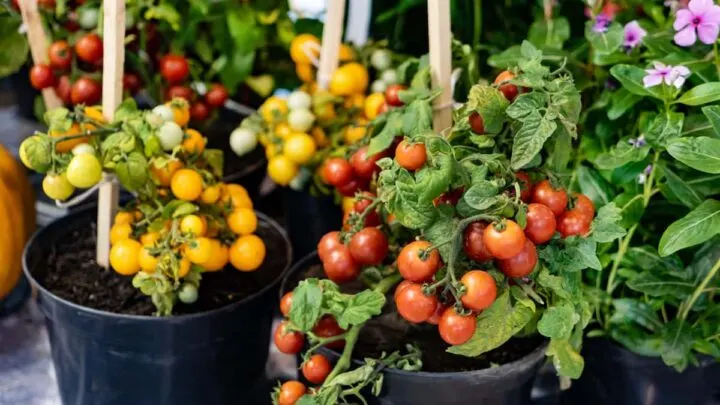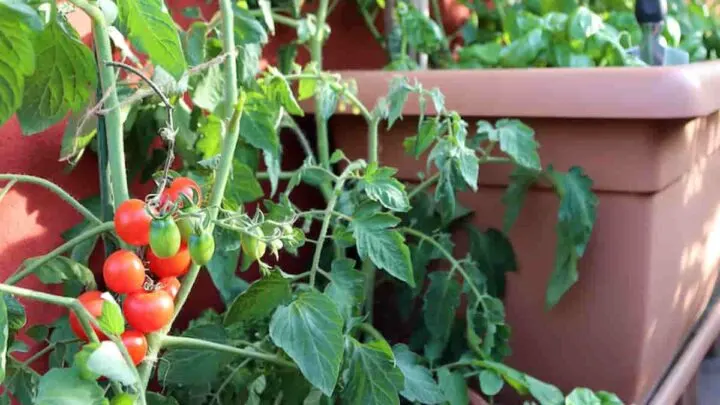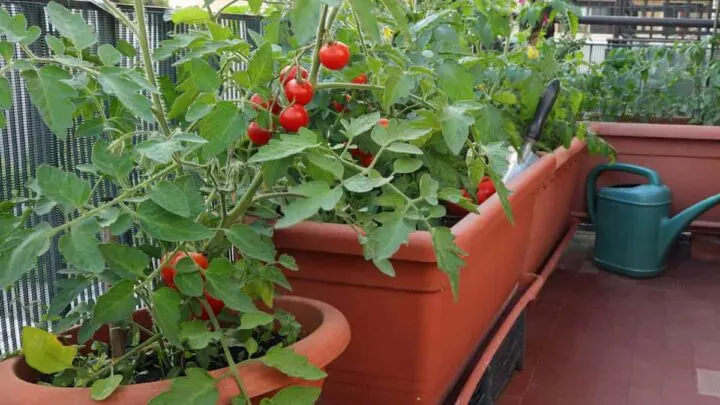Tomatoes are a gardener’s favorite vegetable to grow. But if you don’t have a garden plot in your yard or don’t want to do the digging involved in starting one, can you still grow tomatoes? You’ve seen the potted tomatoes at the garden center. Does that method work? Why grow tomatoes in pots?
There are several advantages to growing tomatoes in pots rather than planting them in the ground. The amount of space available, moving the pots, making your own potting mix or buying pre-made, and extending the growing season are just a few of the benefits of potted tomatoes.
Now that you know you can grow tomatoes in pots, you may have questions. Read on to learn the benefits of growing tomatoes this way, what you need to know to succeed, and more.

Small Spaces
One of the best reasons to grow tomatoes in pots is that you don’t need much space. Those living in apartments or condominiums can set up pots on their balcony or patio, as long as they have enough sun. Those who rent a house don’t need to dig up the landlord’s yard or build raised beds to plant a garden.
Portability
Another great reason is that you can move them around, unlike a garden plant. If needed, a pot can be moved inside or to a sheltered area to avoid weather damage. You can move the pot to keep the plant out of bad weather conditions: cold, strong wind, heavy rain, or hail.
You can also move the pot to follow the sun if needed.
Extend the Growing Season
You can start seeds inside to get an early start to the season. If it gets cold, bring the pot inside at night and put it out when it’s warm again the next day.
The same is true for the end of the season. Bring pots inside when it gets cold to keep them growing longer into the fall.

Control Over Growing Conditions
Soil composition is up to you. You can mix up your own soil more easily to fill the pot than augmenting garden soil. No more using a pitchfork to turn over the earth. You can do enough for one pot at a time, so less physical labor is required.
There are high-quality pre-mixed potting soils you can buy. Compost can be added to them or make up your own mixture of soil, perlite, etc.
Drainage is easy by having holes in the bottom of the pot with stones or gravel over the hole. Even a long period of heavy rain won’t get the plants soggy, as can happen in a garden plot.
Tomato Varieties
There are several varieties of tomatoes to choose from. For pots, the best are determinate, patio, bush, dwarf, or micro dwarf.
There are two types of tomatoes: determinate and indeterminate. Determinate tomatoes reach their maximum height (usually 3-4 feet) and set all the fruit at once. Indeterminate tomatoes continue to grow (can become over 6 feet) and bear fruit until they are killed by frost.
Most of the dwarf tomatoes are indeterminate. However, dwarf plants will grow to a limited height because of how they’ve been developed.
Dwarf and Micro Dwarf Tomatoes
These types of tomatoes can be grown indoors in as small as a 6-inch pot. If you have a sunny windowsill, you can grow tomatoes!
The dwarf in the name refers to the size of the plant, not the tomato. Dwarf tomatoes reach a height of 2-4.5 feet; micro dwarfs only grow to 6-8 inches tall.

Variety of Containers
There are pots and containers of different materials, colors, and styles. You can choose your favorite color and look from plastic to terracotta and clay, to ceramic, to grow bags.
Note that terracotta and clay pots are porous, and you may need to water more often since tomatoes like to be kept moist. Some liners can be used to block water seepage. Ceramic pots look nice, but mold can become an issue as well as disease if the plants aren’t monitored. Liners can also be used in these pots to help prevent mold.
These types of pots are heavy, especially in the sizes needed for 3-4′ tomato plants. They’re also more expensive than plastic.
Plastic containers are great but can deteriorate or crack from the cold or prolonged sun exposure.
Grow bags are relatively new to the scene and come in several sizes and shapes. They’re an appealing choice, providing good drainage and may have handles to make moving them easier. They’re usually made from pressed fabric or polypropylene. They can last 7-8 seasons, maybe more.
Convenience
If you get 6-8 hours of sun in the right place, you can have your potted tomatoes just outside the kitchen or patio door. This makes harvesting your fresh tomatoes very easy. Tomatoes need at least six hours of sun, eight is better, so this might not be the best spot to keep them if there’s less.
Easy to Care For
Since your pots are usually close to the house, you don’t have to walk out to the garden to water and fertilize the plants or pick your delicious home-grown tomatoes.
Easy to Add Another Variety
If you want to grow another variety of tomato, just get another pot ready and transplant a seedling into it.

Ways to Grow Tomatoes Inside
When you don’t have a window that receives enough sunlight, there are various setups with grow lights or LED lights you can use to grow tomatoes inside all year long. They can be units with two or four shelves or compact hydroponic units holding 2-3 plants. The larger units can accommodate dwarf plants up to a few feet. Micro dwarf tomatoes are easy to grow in small units.
Plant Supports
Some pots have built-in trellises in them, which makes things easy. Or you can use a tomato cage or stake to support the plant. There are all sizes and shapes of cages, so it’s easy to find one to fit your pot and plant.
You want the cage’s legs to go all the way down to the bottom of the pot to keep it from falling over as the plant grows with fruit.
Protection From Critters
If your pots are on a 2nd story or higher balcony, deer, rabbits, and groundhogs won’t be able to reach your tomato plants. But chipmunks, squirrels, raccoons, and birds may still be able to do damage. Determining what animals you need to guard against depends on the height of your pots and where they are located.
To protect your plants, put netting or mesh over the plants. You can use a strong-smelling deterrent for deer, but it won’t work for long. They will become adapted to the smell. If your pots are on a patio, block deer access to it with a gate. Some say the best way to keep deer away from your potted tomatoes is to have a dog.
Protection From Diseases
Tomato diseases that live in the garden won’t be a problem for your potted plants since you start with new soil each year.
Blossom end rot, where the blossom end of tomatoes rot and turn black, can still be a problem. This occurs when the watering is inconsistent or the plant is not getting enough calcium.
Protection From Cold
When there is a danger of frost or the temperature will dip below 50 degrees, you’ll need to cover your plants, bring them inside, or put them in a shed that won’t get too cold inside.
Another option is a water wall, which is put around your tomato plant, and filled with water. This creates insulation for your plant and will also protect your plant from strong wind.
Tips for Growing Tomatoes in Pots
Grow only one plant per pot.
A self-watering pot with a reservoir to hold water can extend the time between watering. This can help when you’re away for a weekend.
Even though these plants are not very large at maturity, staking or caging them should be done when they are young. It’s easier than waiting until the plant has grown and has started producing tomatoes.
Recommendations for pot size vary, but for best production, bigger is better.
Add a handful of slow-release fertilizer when planting your seedling. Continue fertilizing over the growing season. As tomatoes appear, a fertilizer higher in phosphorus and lower in nitrogen will aid tomato production.
A Downside to Tomatoes in Pots
The most important thing to keep up with is watering the plants enough to keep them moist. In hot weather, pots can dry out quickly. If you live in a hot area, you may have to water once or twice daily.
Final Thoughts
As you’ve seen, several smaller tomato varieties can be grown in pots, whether outside or inside. As long as you provide the plant with sufficient light, water, and nutrients, you will have ample fresh, tasty tomatoes.
You are limited only by your available space for the pots or bags. For very limited space, you can try the micro dwarf tomatoes inside in a sunny window or under grow lights.
Growing tomatoes in pots can be easier than having a traditional garden. You don’t have to turn over or till the soil. You can have tomatoes even if you live in an apartment with a sunny balcony. At home, a space in your kitchen for plants under grow lights will provide you with red, juicy tomatoes. Enjoy.

Hi there, my name is Allie and welcome to my blog; GareningWithAllie!
Much of what you see written here is just our personal experiences with gardening. Along with the content I write here, there is also a unique collection of gardening topics covered by some of our close friends. I hope you find everything you read here to be helpful, informative, and something that can make your gardening journey the most lovely experience ever! With that said, Happy Gardening!
